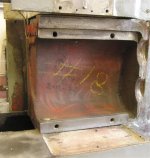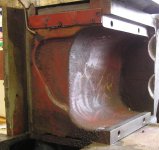DaveE907
Titanium
- Joined
- Sep 18, 2007
- Location
- Spanish Springs, NV
Gearbox removal has been addressed before but there were errors in some of the texts along with a lack of photos depicting what was being talked about. I recently removed the gearbox from my 10EE square dial for some work and thought it might be worthwhile to document the process. Hope someone finds it useful.
There are a number of photos so to be kind to those of us without broadband they're posted as attachments. Click on any you want to see a larger version of. Due to forum limitations this will continue for multiple posts.
These steps do not have to proceed in the exact sequence I used but they need to be accomplished to get the task done.
1) Remove belt idlers, feed belt and spindle drive belts.
2) Disconnect leadscrew and feed rod from gearbox, withdraw ELSR rod if so equipped.
3) Drain gearbox oil (optional at this point but highly recommended).
4) Remove the taper pin holding the upper speed control sprocket to its shaft, slide it off the shaft and remove the chain. Pull on the speed control knob to extract the shaft.
5) Remove the backgear linkage rod.
6) Use a face spanner to remove the screw holding the Thread/Feed knob to the headstock, remove the spring, pull knob off shaft and remove the woodruff key from the shaft.
7) Remove the three 1/4-20 SHCS holding the housing to the headstock and the housing pulls straight off.
There are a number of photos so to be kind to those of us without broadband they're posted as attachments. Click on any you want to see a larger version of. Due to forum limitations this will continue for multiple posts.
These steps do not have to proceed in the exact sequence I used but they need to be accomplished to get the task done.
1) Remove belt idlers, feed belt and spindle drive belts.
2) Disconnect leadscrew and feed rod from gearbox, withdraw ELSR rod if so equipped.
3) Drain gearbox oil (optional at this point but highly recommended).
4) Remove the taper pin holding the upper speed control sprocket to its shaft, slide it off the shaft and remove the chain. Pull on the speed control knob to extract the shaft.
5) Remove the backgear linkage rod.
6) Use a face spanner to remove the screw holding the Thread/Feed knob to the headstock, remove the spring, pull knob off shaft and remove the woodruff key from the shaft.
7) Remove the three 1/4-20 SHCS holding the housing to the headstock and the housing pulls straight off.






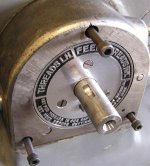


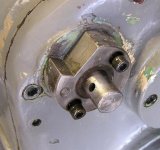





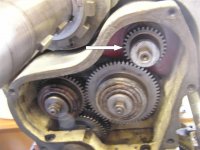






 The two output shafts for the carriage drive use labyrinth seals. I replaced these with conventional neoprene lipped seals. I don't have a part# in front of me, but the shaft and housing size are standard, and they install perfectly. I painted the inside like the headstock with the Klink's tub and basin expoxy, which now after a few years imersed in oil, shows no sign of softening and is tough and shiny as the day I put it on.
The two output shafts for the carriage drive use labyrinth seals. I replaced these with conventional neoprene lipped seals. I don't have a part# in front of me, but the shaft and housing size are standard, and they install perfectly. I painted the inside like the headstock with the Klink's tub and basin expoxy, which now after a few years imersed in oil, shows no sign of softening and is tough and shiny as the day I put it on. Don't mess with one of these without preparation.
Don't mess with one of these without preparation.
